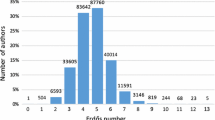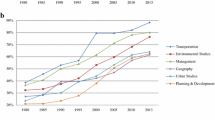Abstract
We investigate whether Nobel laureates’ collaborative activities undergo a negative change following prize reception by using publication records of 198 Nobel laureates and analyzing their coauthorship patterns before and after the Nobel Prize. The results overall indicate less collaboration with new coauthors post award than pre award. Nobel laureates are more loyal to collaborations that started before the Prize: looking at coauthorship drop-out rates, we find that these differ significantly between coauthorships that started before the Prize and coauthorships after the Prize. We also find that the greater the intensity of pre-award cooperation and the longer the period of pre-award collaboration, the higher the probability of staying in the coauthor network after the award, implying a higher loyalty to the Nobel laureate.









Similar content being viewed by others
Notes
We have compared the publication records from Web of Science with those from Scopus for a random sample of 50 Laureates. On average, Scopus has 6.14 more publication records than the Web of Science database for each of Laureate.
Nobel laureates who passed away before 1st January, 2015.
Dropout rate is measured by the number of pre-award coauthors’ dropouts divided by the number of current pre-award coauthors.
An abundant literature has shown significant gender difference in research collaboration structure; see Abramo et al. (2013) for a recent review.
Results are available upon request.
References
Abramo, G., D’Angelo, C. A., & Murgia, G. (2013). Gender differences in research collaboration. Journal of Informetrics, 7, 811–822.
Baffes, J., & Vamvikidis, A. (2011). Are you too young for the Nobel Prize? Research Policy, 40, 1345–1353.
Beaver, D. D. (2001). Reflections on scientific collaboration, (and its study): Past, present, and future. Scientometrics, 52, 365–377.
Börner, K., Contractor, N., Falk-Krzesinski, H. J., Fiore, S. M., Hall, K. L., Keyton, J., et al. (2010). A multi-level systems perspective for the science of team science. Science Translational Medicine, 2(49), 49cm24.
Bozeman, B., & Corley, E. (2004). Scientists’ collaboration strategies: Implications for scientific and technical human capital. Research Policy, 33, 599–616.
Chan, H. F., Gleeson, L., & Torgler, B. (2014). Awards before and after the Nobel Prize: A matthew effect and/or a ticket to one’s own funeral. Research Evaluation, 23, 210–220.
Chan, H. F., Önder, A. S., & Torgler, B. (2015). The first cut is the deepest: Repeated interactions of coauthorship and academic productivity in nobel laureate teams. CREMA Working Papers No 2015–04, CREMA, Zurich.
Chan, H. F., & Torgler, B. (2013). Time-lapsed awards for excellence. Nature, 300, 29.
Chan, H. F., & Torgler, B. (2015). The implications of educational and methodological background for the career success of nobel laureates: An investigation of major awards. Scientometrics, 102, 847–863.
Dietz, J. S., & Bozeman, B. (2005). Academic careers, patents, and productivity: Industry experience as scientific and technical human capital. Research Policy, 34, 349–367.
Gingras, Y., & Wallace, M. L. (2010). Why it has become more difficult to predict Nobel Prize winners: A bibliometric analysis of nominees and winners of the chemistry and physics prizes (1901–2007). Scientometrics, 82, 401–412.
Ham, J. C., & Weinberg, B. A. (2011). Geography and innovation: Evidence from Nobel laureates. Unpublished manuscript.
Heinze, T., & Kuhlmann, S. (2008). Across institutional boundaries? Research collaboration in German public sector nanoscience. Research Policy, 37, 888–899.
Jones, B. F., & Weinberg, B. A. (2011). Age dynamics in scientific creativity. PNAS, 108, 18910–18914.
Kademani, B. S., Kalyana, V. L., Kumar, V., & Mohan, L. (2005). Nobel laureates: Their publication productivity, collaboration and authorship status. Scientometrics, 62, 261–268.
Katz, S. J., & Martin, B. R. (1997). What is research collaboration? Research Policy, 26, 1–18.
Marton, F., Fensham, P., & Chaiklin, S. (1994). A Nobel’s eye view of scientific intuition: Discussions with the Nobel prize-winners in physics, chemistry and medicine (1970–86). International Journal of Science Education, 16, 457–473.
Merton, R. K. (1968). The Matthew effect in science. The reward and communication systems of science are considered. Science, 159, 56–63.
Rothenberg, A. (2005). Family background and genius II: Nobel laureates in science. Canadian Journal of Psychiatry, 50, 918–925.
Shaman, J., Solomon, S., Colwell, R. R., & Field, C. B. (2013). Fostering advances in interdisciplinary climate science. PNAS, 110, 3653–3655.
Shavinina, L. V. (2004). Explaining high abilities of Nobel laureates. High Ability Studies, 15, 243–254.
Stephan, P. E., & Levin, S. G. (1993). Age and the Nobel Prize revisited. Scientometrics, 28, 387–399.
Stokols, D., Hall, K. L., Taylor, B. K., & Moser, R. P. (2008). The science of team science: Overview of the field and introduction to the supplement. American Journal of Preventive Medicine, 25, S77–S89.
van Dalen, H. P. (1999). The golden age of Nobel economics. The American Economist, 43, 19–35.
van Rijnsoever, F. J., & Hessels, L. (2011). Factors associated with disciplinary and interdisciplinary research collaboration. Research Policy, 40, 463–472.
Wray, K. B. (2006). Scientific authorship in the age of collaborative research. Studies in History and Philosophy of Science, 37, 505–514.
Wuchty, S., Jones, B. F., & Uzzi, B. (2007). The increasing dominance of teams in production of knowledge. Science, 316(5827), 1036–1039.
Zuckerman, H. (1992). The proliferation of prizes: Nobel complements and Nobel surrogates in the reward system of science. Theoretical Medicine, 13, 217–231.
Zuckerman, H. (1996). Scientific elite: Nobel laureates in the United States. New Brunswick: Transaction Publishers.
Acknowledgments
For advice and suggestions, thanks are due to two anonymous referees. We acknowledge financial support from the Australian Research Council (FT110100463).
Author information
Authors and Affiliations
Corresponding author
Rights and permissions
About this article
Cite this article
Chan, H.F., Önder, A.S. & Torgler, B. Do Nobel laureates change their patterns of collaboration following prize reception?. Scientometrics 105, 2215–2235 (2015). https://doi.org/10.1007/s11192-015-1738-8
Received:
Published:
Issue Date:
DOI: https://doi.org/10.1007/s11192-015-1738-8




